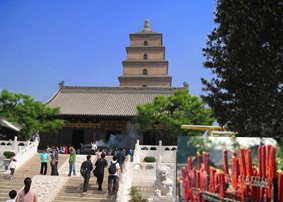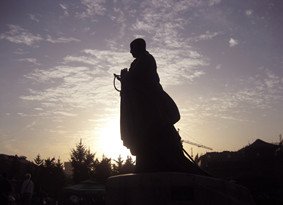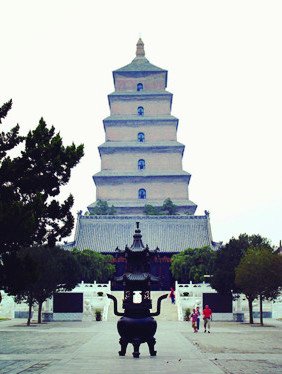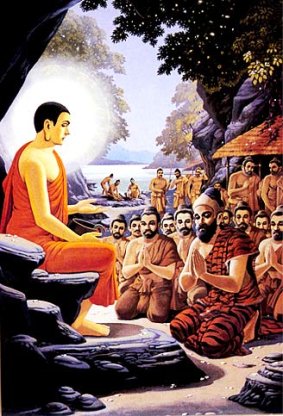Brief Introduction
Situated in Da Ci’en Templ e in the south surburb of Xi’an, the Big Wild Goose Pagoda is one of the most famous Buddhism pagodas in China. The Da Ci’en temple was originally built in 589 AD in the Sui Dynasty, and then was repaired and enlarged in about 648 AD in the Tang Dynasty, when Emperor Lizhi was still a crown prince. Lizhi was a filial son. He built this temple in order as a thanks-giving to his mother Empress Wende who died young, so the temple is also called‘Thanks-giving temple’. The temple once consisted of 1,879 magnificent rooms. However, itwent into gradual decay after the downfall of the Tang Dynasty.
e in the south surburb of Xi’an, the Big Wild Goose Pagoda is one of the most famous Buddhism pagodas in China. The Da Ci’en temple was originally built in 589 AD in the Sui Dynasty, and then was repaired and enlarged in about 648 AD in the Tang Dynasty, when Emperor Lizhi was still a crown prince. Lizhi was a filial son. He built this temple in order as a thanks-giving to his mother Empress Wende who died young, so the temple is also called‘Thanks-giving temple’. The temple once consisted of 1,879 magnificent rooms. However, itwent into gradual decay after the downfall of the Tang Dynasty.
The pagoda was built in 652 AD in the Tang Dynasty. Xuanzang, one of the most famous Buddhist masters and the first Abbot of this temple, proposed to the imperial court to build a pagoda to store the scriptures and statues he brought back from India. The emperor readily agreed with him. The pagoda was finished in the same year with only five storeys. During the following dynasties, the pagoda withstood wars and weather, but was still destroyed in a certain level. It was repaired, renovated and added to many times. Now it is 64 meters high with seven storeys. It is in a wood-and-brick structure without the use of any cement. The Dougong (bracket) in traditional Chinese architecture features the construction of the pagoda. The seams between each layer of bricks and the so-called ‘prisms’ on each side can be seen clearly. It is really an architectural marvel.
In the Tang dynasty, every successful candidate in the state imperial examination would climb up the pagoda to write poems and inscriptions on different doors and frameworks, symbolizing a soaring career in the future. Today we can still find some inscriptions inside the pagoda.
Background Knowlege
Who is Xuanzang?
In the South Square in front of the pagoda, there is a bronze statue. He is Xuanzang, the head of this temple in the Tang Dynasty. He was a great translator and traveler as well. Born in a poor family, he became a monk at the age of 11. By the time he was 26, he found there were so many mistakes in the translation of Buddhist works that he made up his mind to travel to India to discover the original Buddhist Sanskrit. At the age of 28 in 627, he journeyed to India to study Buddhist scriptures. After 17 years of research on Buddhism, the returned to Chang’an, the ancient Xi’an and the Tang’s capital, with 657 volumes of Buddhist scriptures. Xuanzang was warmly welcome by the imperial court because of his unique knowledge of India and central Asia, and his deep knowledge of Buddhist doctrines. The emperor admitted that he could stay in the Da Ci’en Temple to translate the Buddhism scriptures he took back from India. Xuanzang stayed in this temple for 12 years and translated 1,335 volumes of Buddhism scriptures.Xuanzang finally moved to Yuhua Palace in present Tongchuan, and nirvanaed there at the age of 64 in 664 AD.
head of this temple in the Tang Dynasty. He was a great translator and traveler as well. Born in a poor family, he became a monk at the age of 11. By the time he was 26, he found there were so many mistakes in the translation of Buddhist works that he made up his mind to travel to India to discover the original Buddhist Sanskrit. At the age of 28 in 627, he journeyed to India to study Buddhist scriptures. After 17 years of research on Buddhism, the returned to Chang’an, the ancient Xi’an and the Tang’s capital, with 657 volumes of Buddhist scriptures. Xuanzang was warmly welcome by the imperial court because of his unique knowledge of India and central Asia, and his deep knowledge of Buddhist doctrines. The emperor admitted that he could stay in the Da Ci’en Temple to translate the Buddhism scriptures he took back from India. Xuanzang stayed in this temple for 12 years and translated 1,335 volumes of Buddhism scriptures.Xuanzang finally moved to Yuhua Palace in present Tongchuan, and nirvanaed there at the age of 64 in 664 AD.
Xuanzang’s traveling story was then be derived to write a fairy story ‘Traveling to the Western Regions’ by a famous novelist Wu Cheng’en in the Ming Dynasty. The novel has become one of the most famous one in Chinese history, and has been adapted to TV play series, films and cartoons that are specially loved by children. The hero in the novel Monkey King is also well known and very popular both at home and abroad.
How come the name of the pagoda?
Someone may be confused why it is called Big Wild Goose Pagoda. It is said that when Xuanzang studied Buddhism in Indi a, he once stayed in a Mahayana temple, near where there was a Hinayana temple. Do you know the difference between the Mahayana and Hinayana Buddhism? Well, it is two sections of the Buddhism. The Mahayana believers are vegetarians while the Hinayana believers are non-vegetarians. One day, a monk in the Hinayana temple was worried the shortage of meat. It happened to be the General Alms Day of the Buddha, so the monk looked up the sky and said: ‘Our beloved Buddha, the great and merciful, would not forget what day is it today!’ At these words, a flock of wild geese flied over and the head one dropped dead on the ground. Monks in the temple then realized this was what the Buddha gave them for meat. From then on, the Hinayana believers became vegetarians and the monks in the temple built a pagoda on the site where the goose dropped and gave the name of ‘Wild Goose Pagoda’ to commemoratethe dead goose.
a, he once stayed in a Mahayana temple, near where there was a Hinayana temple. Do you know the difference between the Mahayana and Hinayana Buddhism? Well, it is two sections of the Buddhism. The Mahayana believers are vegetarians while the Hinayana believers are non-vegetarians. One day, a monk in the Hinayana temple was worried the shortage of meat. It happened to be the General Alms Day of the Buddha, so the monk looked up the sky and said: ‘Our beloved Buddha, the great and merciful, would not forget what day is it today!’ At these words, a flock of wild geese flied over and the head one dropped dead on the ground. Monks in the temple then realized this was what the Buddha gave them for meat. From then on, the Hinayana believers became vegetarians and the monks in the temple built a pagoda on the site where the goose dropped and gave the name of ‘Wild Goose Pagoda’ to commemoratethe dead goose.
Actually this pagoda was built according to the prototype in India, and it was given the same name in praise of Xuanzang. Later on, another pagoda was built in Jianfu Temple. It is shorter then this one. So it is called ‘Small Wild Goose Pagoda’ while this one is called ‘Big Wild Goose Pagoda’.
Bell Tower and Drum Tower
The two buildings on each side of the road are respectively a Bell Tower and a Drum Tower. The east Bell Tower houses a bell while the west Drum Tower houses a drum. The bell and drum were used to strike time for monks in the temple in ancient times. The bell was made in the Ming dynasty and weights about 15 tons.
The Great Hall of the Buddha
The Great Hall of the Buddha is the most important building in the temple for it is dedicated to the founder of the Buddhism Sakyamuni. Inside the hall is a three-body sculpture of Sakyamuni. The one in the center is Fahen Buddha, the one on the left is Boahen Buddha, and the one on the right is Yingshen Buddha. The figure beside the three-bodied Buddha on the east side is Jia Ye, one of the great disciples of Sakaymuni, and the one on the other side is Ahnan, Sakaymuni’s cousin and his faithful disciple as well. Further on both sides are the eighteen Arhats, also Sakyamuni’s disciples.
Mural Painting about the Story of Sakyamuni
In the hall on the l eft side of the Great Hall of the Buddha, there are reliefs on the wall showinghow Sakyamuni became the founder of the Buddhism. Sakyamuni was a contemporary ofConfucius in China. He was once a prince of the Kingdom of Dapila in India. His mother was sleeping, when she dreamed a white elephant fell down from the sky to her belly. She then became pregnant as soon as she was aware. After 10 months, she went back to his mother’s home to give birth to the prince as a local rule. On her way home, the prince war born under a tree. The boy could speak and walk as soon as he was born. With bright light around him, he walked seven steps, each with a beautiful lotus flower. His one hand pointed to the sky and the other pointed to the ground. He was then named Sakyamuni meaning a saint of the country.
eft side of the Great Hall of the Buddha, there are reliefs on the wall showinghow Sakyamuni became the founder of the Buddhism. Sakyamuni was a contemporary ofConfucius in China. He was once a prince of the Kingdom of Dapila in India. His mother was sleeping, when she dreamed a white elephant fell down from the sky to her belly. She then became pregnant as soon as she was aware. After 10 months, she went back to his mother’s home to give birth to the prince as a local rule. On her way home, the prince war born under a tree. The boy could speak and walk as soon as he was born. With bright light around him, he walked seven steps, each with a beautiful lotus flower. His one hand pointed to the sky and the other pointed to the ground. He was then named Sakyamuni meaning a saint of the country.
His mother died seven days later. He grew up under the care of his aunt. Then he got married and fathered a son. By witnessing so many happiness and bitterness in the imperial palace, he decided to go out to seek a release. At the age of 29, forsaking his wife and son, he left the palace forever to become a wandering ascetic. He cut his hairs and started to meditate the truth of life by facing to a wall.
During the six years ascetic life, he only relied on the fruit and milk given by two shepherdesses.Later, a fiend ordered three hags to disturb Sakyamuni, but he didn’t distract his attention at all. The fiend flied into fury and he kept sending his demons to kill Sakyamuni. All of the demons were defeated. Then at the age of 35, Sakyamuni reached enlightenment under a banyan tree andbecame a Buddha.
In the following 40 years, Sakyamuni traveled over India to preach Buddhism. At the age of 80, he nirvanaed in a serene sleeping gesture. By hearing the news, his disciples all cried and theywent from all over India to pay homage to him. They fired his body and divided his bone relics into eight parts, stored them in clean pots and sent them to different countries to be sacrificed in dagobas. In Shaanxi Famen Temple in Fufeng County, the dagoba hold the finger bones of Sakyamuni.
The Great Tang Sanzang Courtyard
This is a newly built hall with three rooms which display the doctrines Xuanzang translated and the mural paintings of the story of Xuanzang.
Tips
|
Location
|
Yanta Road, Southern Xi’an
|
|
Drive Distance
|
four kilometers (20 minutes) away from the center of the city
|
|
Opening Time
|
Dec-Feb: 8:00 to 18:00
|
|
Mar-Nov: 8:00 to 18:30
|
|
Ticket Price of Da Ci’en Temple
|
Mar-Nov: RMB50yuan per person (not including climbing up the pagoda)
|
|
Dec-Feb: RMB 30yuan per person (not including climbing up the pagoda)
|
|
Ticket of Climbing up the Pagoda
|
Mar-Nov: RMB 30yuan per person
|
|
Dec-Feb: RMB 20yuan per person
|
|
Visiting Time
|
one and half hour
|






 e in the south surburb of Xi’an, the Big Wild Goose Pagoda is one of the most famous Buddhism pagodas in China. The Da Ci’en temple was originally built in 589 AD in the Sui Dynasty, and then was repaired and enlarged in about 648 AD in the Tang Dynasty, when Emperor Lizhi was still a crown prince. Lizhi was a filial son. He built this temple in order as a thanks-giving to his mother Empress Wende who died young, so the temple is also called‘Thanks-giving temple’. The temple once consisted of 1,879 magnificent rooms. However, itwent into gradual decay after the downfall of the Tang Dynasty.
e in the south surburb of Xi’an, the Big Wild Goose Pagoda is one of the most famous Buddhism pagodas in China. The Da Ci’en temple was originally built in 589 AD in the Sui Dynasty, and then was repaired and enlarged in about 648 AD in the Tang Dynasty, when Emperor Lizhi was still a crown prince. Lizhi was a filial son. He built this temple in order as a thanks-giving to his mother Empress Wende who died young, so the temple is also called‘Thanks-giving temple’. The temple once consisted of 1,879 magnificent rooms. However, itwent into gradual decay after the downfall of the Tang Dynasty.
 head of this temple in the Tang Dynasty. He was a great translator and traveler as well. Born in a poor family, he became a monk at the age of 11. By the time he was 26, he found there were so many mistakes in the translation of Buddhist works that he made up his mind to travel to India to discover the original Buddhist Sanskrit. At the age of 28 in 627, he journeyed to India to study Buddhist scriptures. After 17 years of research on Buddhism, the returned to Chang’an, the ancient Xi’an and the Tang’s capital, with 657 volumes of Buddhist scriptures. Xuanzang was warmly welcome by the imperial court because of his unique knowledge of India and central Asia, and his deep knowledge of Buddhist doctrines. The emperor admitted that he could stay in the Da Ci’en Temple to translate the Buddhism scriptures he took back from India. Xuanzang stayed in this temple for 12 years and translated 1,335 volumes of Buddhism scriptures.Xuanzang finally moved to Yuhua Palace in present Tongchuan, and nirvanaed there at the age of 64 in 664 AD.
head of this temple in the Tang Dynasty. He was a great translator and traveler as well. Born in a poor family, he became a monk at the age of 11. By the time he was 26, he found there were so many mistakes in the translation of Buddhist works that he made up his mind to travel to India to discover the original Buddhist Sanskrit. At the age of 28 in 627, he journeyed to India to study Buddhist scriptures. After 17 years of research on Buddhism, the returned to Chang’an, the ancient Xi’an and the Tang’s capital, with 657 volumes of Buddhist scriptures. Xuanzang was warmly welcome by the imperial court because of his unique knowledge of India and central Asia, and his deep knowledge of Buddhist doctrines. The emperor admitted that he could stay in the Da Ci’en Temple to translate the Buddhism scriptures he took back from India. Xuanzang stayed in this temple for 12 years and translated 1,335 volumes of Buddhism scriptures.Xuanzang finally moved to Yuhua Palace in present Tongchuan, and nirvanaed there at the age of 64 in 664 AD.
 a, he once stayed in a Mahayana temple, near where there was a Hinayana temple. Do you know the difference between the Mahayana and Hinayana Buddhism? Well, it is two sections of the Buddhism. The Mahayana believers are vegetarians while the Hinayana believers are non-vegetarians. One day, a monk in the Hinayana temple was worried the shortage of meat. It happened to be the General Alms Day of the Buddha, so the monk looked up the sky and said: ‘Our beloved Buddha, the great and merciful, would not forget what day is it today!’ At these words, a flock of wild geese flied over and the head one dropped dead on the ground. Monks in the temple then realized this was what the Buddha gave them for meat. From then on, the Hinayana believers became vegetarians and the monks in the temple built a pagoda on the site where the goose dropped and gave the name of ‘Wild Goose Pagoda’ to commemoratethe dead goose.
a, he once stayed in a Mahayana temple, near where there was a Hinayana temple. Do you know the difference between the Mahayana and Hinayana Buddhism? Well, it is two sections of the Buddhism. The Mahayana believers are vegetarians while the Hinayana believers are non-vegetarians. One day, a monk in the Hinayana temple was worried the shortage of meat. It happened to be the General Alms Day of the Buddha, so the monk looked up the sky and said: ‘Our beloved Buddha, the great and merciful, would not forget what day is it today!’ At these words, a flock of wild geese flied over and the head one dropped dead on the ground. Monks in the temple then realized this was what the Buddha gave them for meat. From then on, the Hinayana believers became vegetarians and the monks in the temple built a pagoda on the site where the goose dropped and gave the name of ‘Wild Goose Pagoda’ to commemoratethe dead goose.
 eft side of the Great Hall of the Buddha, there are reliefs on the wall showinghow Sakyamuni became the founder of the Buddhism. Sakyamuni was a contemporary ofConfucius in China. He was once a prince of the Kingdom of Dapila in India. His mother was sleeping, when she dreamed a white elephant fell down from the sky to her belly. She then became pregnant as soon as she was aware. After 10 months, she went back to his mother’s home to give birth to the prince as a local rule. On her way home, the prince war born under a tree. The boy could speak and walk as soon as he was born. With bright light around him, he walked seven steps, each with a beautiful lotus flower. His one hand pointed to the sky and the other pointed to the ground. He was then named Sakyamuni meaning a saint of the country.
eft side of the Great Hall of the Buddha, there are reliefs on the wall showinghow Sakyamuni became the founder of the Buddhism. Sakyamuni was a contemporary ofConfucius in China. He was once a prince of the Kingdom of Dapila in India. His mother was sleeping, when she dreamed a white elephant fell down from the sky to her belly. She then became pregnant as soon as she was aware. After 10 months, she went back to his mother’s home to give birth to the prince as a local rule. On her way home, the prince war born under a tree. The boy could speak and walk as soon as he was born. With bright light around him, he walked seven steps, each with a beautiful lotus flower. His one hand pointed to the sky and the other pointed to the ground. He was then named Sakyamuni meaning a saint of the country.

